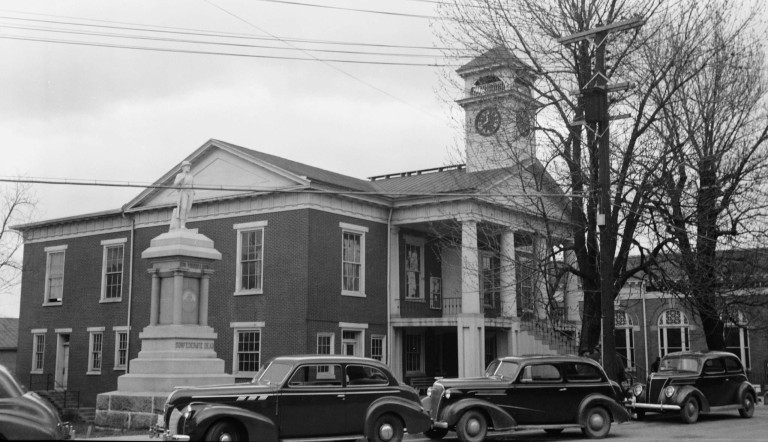
**This research was first published in the March 12, 2025 edition of the Chatham Star-Tribune newspaper as part of Kyle Griffith’s weekly segment entitled “Heritage Highlights.”
Chatham Courthouse as it appeared in 1941. Photo courtesy of the Historic American Buildings Survey
As the Virginia Piedmont receded westward to settlement by colonists during the mid-1700s, courthouses developed as important outposts of law and order on the frontier. The placement of new county seats laid the foundations of future growth in the surrounding areas. The historic Fry-Jefferson Map drawn in 1751 shows that settlement west of Petersburg, Virginia was in a stage of infancy. The county of Lunenburg encapsulated the land of nine future counties as far south as North Carolina and as far west as the Blue Ridge. Its courthouse was located northeast of what they knew as the “Occoneechee Islands,” which is in modern day Mecklenburg County. As settlements continued to grow, more courthouses popped up in the centers of new counties created from the frontier, leading to the development of Halifax County, the town of Peytonsburg, and the county of Pittsylvania which split from the western division of Halifax in 1767.
Chatham’s early town history follows a similar pattern as the development of other county seats throughout the state. At first the courthouse was placed near Sandy River at what is now Callands, but after the formation of Patrick Henry County in 1777, Cherrystone Creek became the new central location within Pittsylvania County. The surrounding land became prime for the development of a new town. Chatham’s 1853 courthouse reflects the same style as other judicial buildings constructed throughout the mid-19th century. They were imposing brick structures built with elements of classical architecture like the grand columned temples of Ancient Greece. Courthouses also became the center of funding and planning for roads in the county. Several early roads led across the best naturally traversable paths east to Halifax, or north toward ferries, fords, and major plantations near Staunton River, as well as south to the Dan River. Both rivers served as main routes for the exportation of cured tobacco to eastern towns.
Lawyers, judges, traders, tavern keepers, and other entrepreneurs established their workplaces within the viewscape of the courthouse. Nearby farmers and craftsmen flocked in to attend administrative meetings, vote in elections, take part in auctions, open markets, and to witness other speeches and spectacles. Some courthouse lawns served as muster grounds for local militia and military groups during wartime years. The lawn often featured pairs of stocks for publicly restraining criminals at the ankles, gallows for the enforcement of public hangings, and small jails to keep prisoners. Before the establishment of local newspapers, important events were posted on the courthouse bulletin board alongside other advertisements and official notices. Courthouse steps hosted many debates and enabled the town gossip to spread throughout the community.
Prior to the automobile, a round trip journey by horse to conduct business at Virginia’s courthouses usually took longer than a day. Settlers in the backcountry had to travel to town or a well-informed country business in order to learn about the local and worldly news. As a result, commodious taverns and other stagecoach stops of respectable quality were constructed near the courthouse to host traveling state officials as well as the local administrators and townsmen. Further northeast in Virginia, at Hanover Courthouse the landscape remains remarkably preserved in the situation of its 1730s courthouse, the surrounding lawn, 1830s jail, and historic Hanover Tavern directly across the road. Many towns like Chatham, Amherst, or Appomattox (AKA Clover Hill) started out with a similar situation of buildings, but grew further into the commercialized aspects of a town. Leading judges and clerks usually acquired large landholdings near the courthouse, leading to an expansion in logging, brickmaking, and overall land improvement. New stables, farriers, blacksmiths, wheelwrights, distillers, and more supplied the budding county seat. Founding families also developed churches, schools, and burial grounds.
From this brief look into the historic trends of county seats, one can imagine how they developed into towns consisting of several thousand people over a few generations. Other towns were established without courthouses and were more centered around strategic water ports, crossroads, and natural other resources. After the development of the railroad, towns popped up quicker than ever before. Still, historic courthouses remain at the heart of county history. Lifetimes of knowledge and experiences have shaped the identities of people who are proud to come from a town like Chatham.

